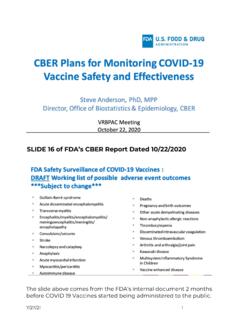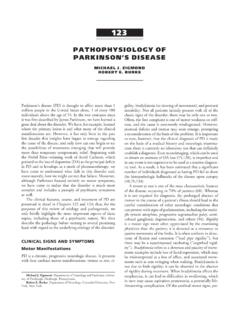Transcription of UPDATE 6-9-21: JHMI Clinical Recommendations for ...
1 UPDATE 6-9-21_PGA 1 JHMI Clinical Recommendations for Pharmacologic Treatment of COVID-19 Updated 6/9/2021 and replaces the version of April 5, 2021; COVID-19 Treatment Guidance Writing Group of Johns Hopkins University and The Johns Hopkins Hospital COVID-19 Treatment Guidance Working Group New in the 6/9/2021 UPDATE | Go to current Writing Group Recommendations New Recommendations for remdesivir treatment in immunocompromised patients Updated tocilizumab eligibility requirements Updated figure, Schematic of Clinical Course of Severe COVID-19 New data on monoclonal antibody therapies: bamlanivimab/etesevimab, casirivimab/imdevimab, and sotrovimab. New data on tocilizumab, sarilumab, lenzilumab, and baricitinib. Appendix A: Comparison of Selected Studies of Targeted Immunosuppression Appendix B: Johns Hopkins Medicine Umbrella Protocol for Requests for Emergency Use of Casirivimab/Imdevimab and Remdesivir Contents I.
2 2 Box 1: Resources for Johns Hopkins Clinicians .. 2 II. Natural History of COVID-19 Disease .. 3 Figure. Schematic of Clinical Course of Severe 4 III. Current Writing Group Recommendations for JHMI .. 4 Box 2: Summary of Clinical Recommendations for Pharmacologic Treatment of COVID-19 .. 4 IV. Approaches to Pharmacologic Treatment of COVID-19 .. 5 A. Viral Suppression .. 5 Remdesivir .. 6 Box 3: JHHS Formulary Management and Medication-Use Policy Committee Restriction for 8 Box 4: Remdesivir Treatment for Substantially Immunocompromised Patients .. 10 Convalescent Plasma .. 10 Box 5: Convalescent Plasma Access .. 13 B. Antibody Mediation or Neutralization .. 13 Monoclonal and Polyclonal Neutralizing Antibodies .. 13 Interferon Beta-1b.
3 16 C. Immune Modulation .. 16 UPDATE 6-9-21_PGA 2 Box 6: Recommendations for the Use of Immune Modulatory Agents to Treat COVID-19 .. 16 Corticosteroids .. 17 Targeted Immune Modulators .. 18 Intravenous Immune Globulin (IVIG) .. 21 V. Agents With Speculative Effect to Avoid as COVID-19 Treatment .. 21 Box 7: Recommendations for Agents to Avoid as Treatment for COVID-19 Specifically .. 21 VI. Development of This Guidance .. 25 Box 8: COVID-19 Pharmacologic Treatment Guidance Writing Group .. 25 References .. 27 Appendix A: Comparison of Selected Studies of Targeted Immunosuppression .. 38 Appendix B: Johns Hopkins Medicine Umbrella Protocol for Requests for Emergency Use of Casirivimab/ Imdevimab and 40 Appendix C: Johns Hopkins Medicine Investigational COVID-19 Convalescent Plasma: A Guide for Patients & Families (9/3/2020).
4 41 I. Purpose The purpose of this document is to provide clinicians at The Johns Hopkins Hospital (JHH) and the Johns Hopkins Health System (JHHS) with guidance for pharmacologic treatment of inpatient and outpatient care of patients diagnosed with coronavirus disease 2019 (COVID-19). This guidance is based on current knowledge, experience, and expert opinion. The goal is to establish and promulgate a standard approach to using pharmacologic agents to treat patients diagnosed with COVID-19. Current approved JH therapeutic protocols for COVID-19: See Johns Hopkins Institute for Clinical and Translational Research: Ongoing COVID-19 Research, including Expanded Access Available non JHH-specific guidelines: See Infectious Diseases Society of America Guidelines on the Treatment and Management of Patients with COVID-19 (which include a systematic assessment of available evidence) and the NI H Coronavirus Disease (COVID-19) Treatment Guidelines.
5 Box 1: Resources for Johns Hopkins Clinicians insideHopkins > Department of Hospital Epidemiology and Infection Control (intranet) VTE Prophylaxis for Symptomatic COVID Positive Patients (intranet or uCentral app) JHH and JHBMC Discharge Guidelines for COVID Positive Patients Still on COVID Isolation (intranet) Johns Hopkins Institute for Clinical and Translational Research: Current Approved Therapeutic Protocols for COVID-19 JHMI Lab Testing Guidance for COVID-19 Inpatients UPDATE 6-9-21_PGA 3 II. Natural History of COVID-19 Disease The natural history of COVID-19 varies considerably among those infected with SARS-CoV-2, most likely due to multiple factors, including, but likely not limited to a patient s health and comorbidities when infected, the exposure inoculum, and potentially, viral genetics.
6 Between 8% and 50% of individuals infected with SARS-CoV-2 have asymptomatic or subclinical Onset of symptomatic infection typically occurs within 4 to 5 days (median) of exposure. It appears that the peak level of viremia is reached at about the time of symptom onset, with high viremia lasting from 2 days prior until approximately 5 days after symptom onset, with no detectable viable virus 8 to 10 days after symptom onset in normal Infectivity parallels high vir al carriage, with the period of contagiousness starting 2 to 5 days before symptom onset and extending to approximately 5 days after symptom onset. Symptomatic infection: Headache, myalgia, and upper respiratory symptoms, including sore throat, a re typical initially. They may be followed a few days later by fever, cough, diarrhea, and anosmia.
7 Overall, any one of these symptoms is observed in between 20% and 80% of patients. The majority of symptomatic patients appear to have mild disease and do not require hospitalization. Patients with mild disease often recover after 7 days of symptoms. Severe disease: More severe disease leading to hospitalization occurs at a mean of 7 days after symptom ,8 A marker of more severe disease is the onset of COVID-19 pneumonia, characterized by fever, cough, fatigue, myalgia, dyspnea, and dyspnea on exertion. R adiographic findings typically include bilateral ground-glass opacities in the lungs; lymphocytopenia is als o commonly ,10 Patients with severe disease may become hypoxic and require high-flow oxygen support or mechanical ventilation to maintain oxygen saturation levels >92%.
8 The risk of progression to severe COVID-19 and hospitalization increases with the presence of specific risk factors, including advanced age, obesity, hypertension, diabetes, chronic lung disease, tobacco use, immune deficiencies, cancer, limited access to health care, and possibly residence in a long-term care Hyperinflammatory syndrome: Some patients progress to disease characterized by hyperinflammation that can include acute respiratory distress syndrome (AR DS) and may occur approximately 5 to 10 days after symptom onset. Fevers characterize the COVID-19 hyperinflammatory syndrome along with rapid worsening of respiratory status; alveolar filling pattern on imaging; often marked elevations in laboratory markers associated with specific inflammatory pathways, such as interleukin-6 (IL-6);17,18 and nonspecific markers of inflammation, including D-dimer, C-reactive protein (CRP), and ferritin.
9 Patients typically have increased levels of cytokines, including IL-6, IL-2R, granulocyte-macrophage colony-stimulating factor (GM-CSF), and tumor necrosis factor-alpha (TNF- ), all of which decline as patients Lymphopenia has also been reported, with declines in CD4+ T cells and CD8+ T These cytokine and lymphocyte profiles have some similarities to those seen in the cytochrome release syndrome (CRS) associated with chimeric antigen receptor T-cell therapy (CAR-T).20 -26 Patients may progress to multiorgan failure as a result of the cytokine-mediated Vascular disease: Microvascular thrombosis and venous thromboembolism also occur with severe Goals and optimal timing of treatment: In this guidance, the timing for administration of pharmacologic agents is based on the type of medication and the potential for direct antiviral effect, modulation of an excessive inflammatory response, or a nonspecific adjuvant effect on the host, as illustrated in the figure below.
10 Outpatient treatment: The primary goal of outpatient treatment is to limit disease progression, which requires treatment initiation early in the disease course, either before symptom onset or shortly thereafter. Inpatient treatment: The 2 therapeutic goals for inpatient treatment are limiting disease progression through antiviral activity and limiting COVID-19-related inflammation. UPDATE 6-9-21_PGA 4 Figure. Schematic of Clinical Course of Severe COVID-19 Representation of SARS-CoV-2 RNA levels correlating with infectious replicating virus (shedding of non-infectious viral RNA may persist for a much longer time), common symptoms, and possible timing of therapeutics for the greatest benefit. Duration of symptoms and viral shedding may be prolonged in some patients who are substantially immunocompromised.




